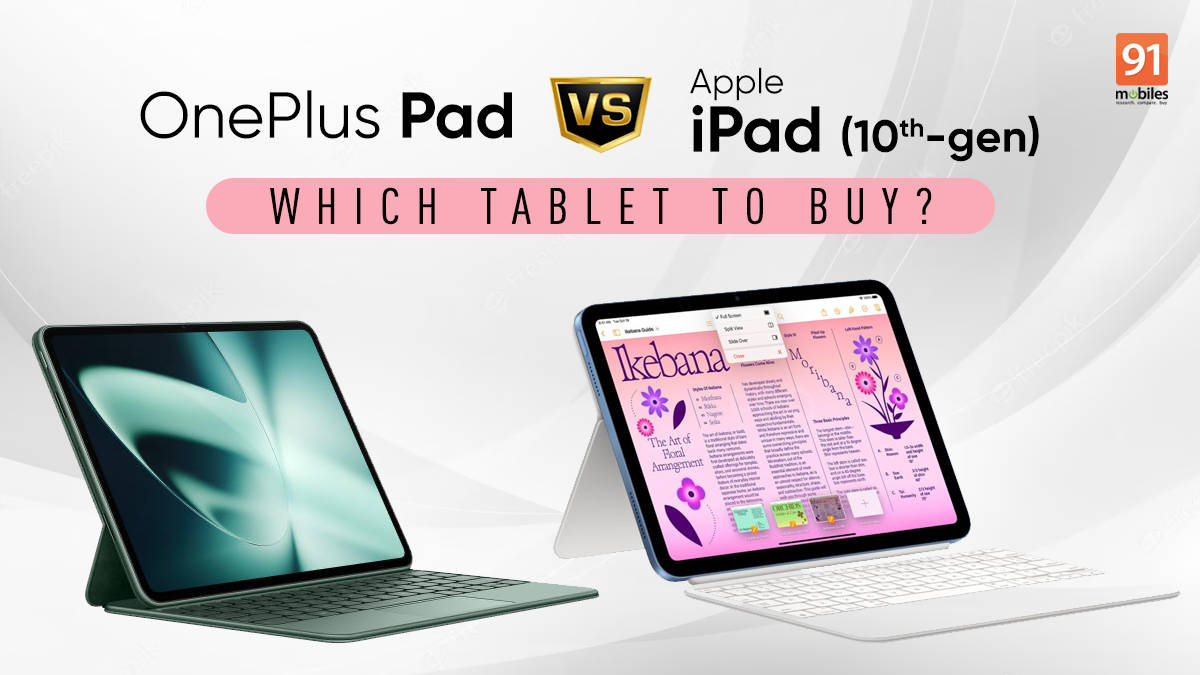
When it comes to tablets, Apple’s iPad has pretty much been the benchmark for all newcomers. A number of brands have tried to dent the dominance of the OG Apple tablet, but with little success. The latest to try its hand to unsettle the iPad is OnePlus. The Never Settling brand has carved out an impressive niche for itself in the smartphones and TWS categories, and now is looking to do the same in the tablet market. And rather than fighting it out in the mid-segment, it has got its sights right on the iPad. This is pretty evident from the price of its first tablet, the OnePlus Pad which starts at Rs 37,999, very close to iPad territory (the latest iPad – the iPad 10th gen is available at around Rs 41,000). But does the OnePlus Pad do enough to rattle the cage of the iPad? We compared the Never Settling tablet with the always settled one to help you make up your mind: (we refer to the iPad 10th generation as the ‘iPad’ for the sake of simplicity).
Table of Contents
Looks and Appearance: Halo Green with envy? Not quite!
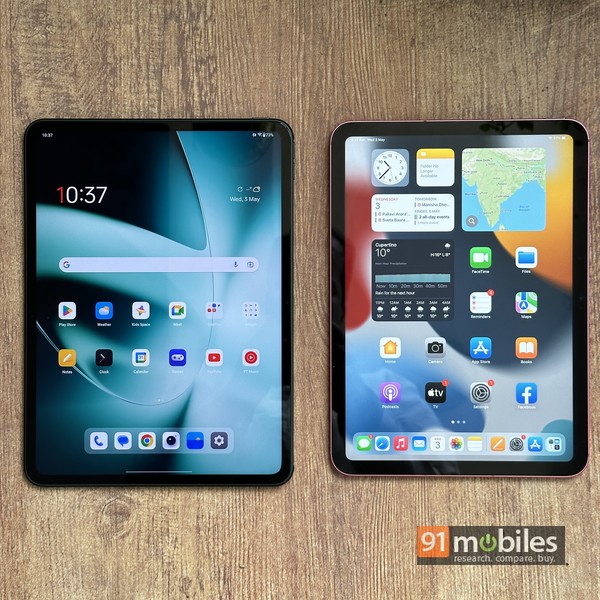
It is metal on the back and glass on the front of both tablets, and both seem a little square-ish in shape. But there the similarity ends. The latest iPad has ditched the slightly curved sides of its predecessors and taken on the straight sides of the iPad Air and Pro range. Gone are the lightning port and the home button beneath the display. The front is a 10.9-inch display, with a display unlock button, which also doubles up as a fingerprint scanner on top, and volume buttons on the top of the right side. The back is totally flat and has a single camera in the top left corner. The OnePlus Pad on the other hand has curves on three sides, and is straight on its right side – to accommodate the charging pad for the stylus, we suspect. The top has a display button (but this one is not a fingerprint scanner) and has volume buttons on the top of the right side. The back is flat-ish but curves towards the sides and rather intriguingly, has a large spherical camera unit which is bang between the top and bottom left edges of the tablet – it is a very odd position for a camera when you hold the tablet in portrait mode, although it seems more natural when you hold it in landscape mode.
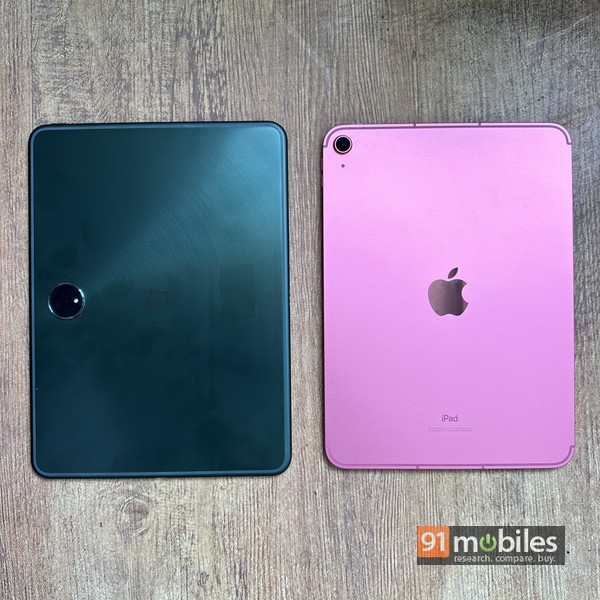
The back of the OnePlus Pad also has a striking green shade, which OnePlus calls Halo Green and a closer look makes it appear as if semi circles were emerging from the right side of the back. The camera placement and the colour make the OnePlus Pad very distinct. But there’s something reassuringly sleek and solid about the iPad as well, especially after its design makeover. Its blue, pink and yellow shades are very striking in their own right. In terms of size, the iPad is more compact and lighter than the OnePlus Pad – 248.6 x 179.5 x 7mm and 481 grams as against 258 x 189.4 x 6.5mm and 552 grams. Which one you prefer really depends on your taste – they both look good. If you are looking for something different, the OnePlus Pad might be more to your liking, but if you are looking for something that is stylish yet recognisable, then the iPad stands tall. We could not find much to choose between the two, so we are calling this one a tie.
Winner: Tie
Display: A refreshing or refresh rate difference
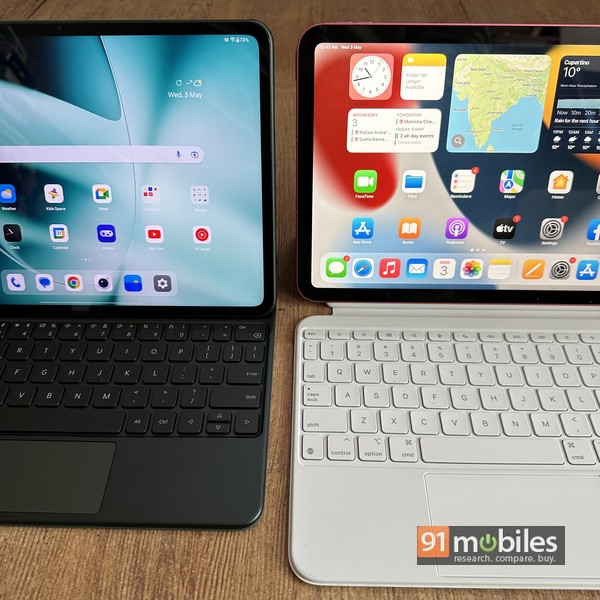
The OnePlus comes with an 11.61-inch display with 144Hz refresh rate and a rather interesting 2,800 x 2,000 resolution, giving it a unique 7:5 aspect ratio. The iPad has a smaller 10.9-inch display with a 60Hz refresh rate and a 2,360 x 1,640 resolution. Both are bright and colourful displays with a brightness of about 500 nits. The higher resolution and refresh rate of the OnePlus Pad might seem to give it an edge on paper, but in terms of viewing experience, we actually found ourselves preferring the iPad, which seemed a little more vibrant. We are going to hand this one to the OnePlus Pad for its spec superiority as regards refresh rate and resolution, but the difference is not really visible.
Winner: OnePlus Pad
Processor and storage: Old Dimensity, Older Bionic…but in an ecosystem
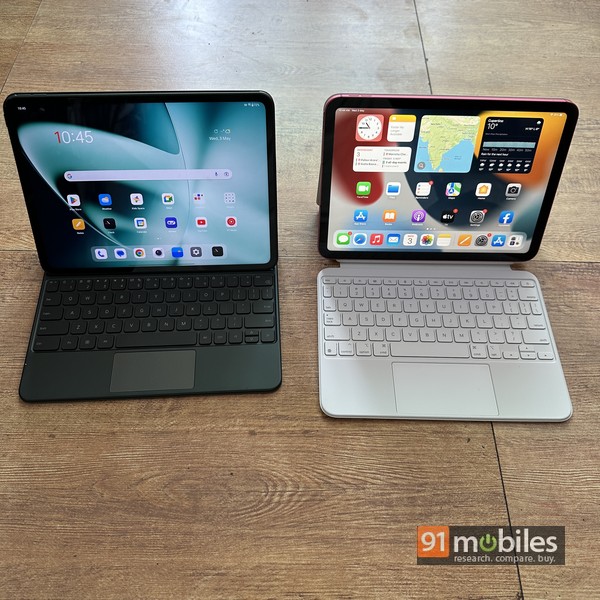
This is a battle between two old-ish processors. The iPad is powered by the A14 Bionic chip released in late 2020, while the OnePlus Pad runs on the MediaTek Dimensity 9000 chip that was released in late 2021. Both, however, are close to flagship level in their own right. Given the fact that both processors work on different platforms, it is difficult to compare them, but we suspect the A14 Bionic would have an edge over the Dimensity 9000 simply because Apple would tweak the OS on the iPad for a more optimized performance. OnePlus’ options in that regard are slightly more limited as it does not make the chip or even the core OS. Both tablets come with 128GB and 256GB, but we are giving the edge to the iPad here, thanks to its chip being more integrated with its ecosystem.
Winner: iPad
Gaming and multimedia: Sights matched, but sound makes a difference
Both tablets come with very good displays, and both have stereo speakers too. The OnePlus Pad, however, has a clear edge here with four speakers as compared to the two on the iPad. This combined with the larger display of the OnePlus Pad makes for a more immersive gaming or video viewing experience. Those games that support it can also take advantage of the higher refresh rate on the OnePlus Pad. That said, games work super smoothly on the iPad as well. You can play Genshin Impact and Call of Duty easily on both these devices, and they are a treat for viewing videos and shows too. The quad-speaker setup wins this round for the OnePlus Pad but it is a close-run thing. Incidentally, neither tablet has a 3.5 mm audio jack.
Winner: OnePlus Pad
Cameras: Say cheese and do video calls
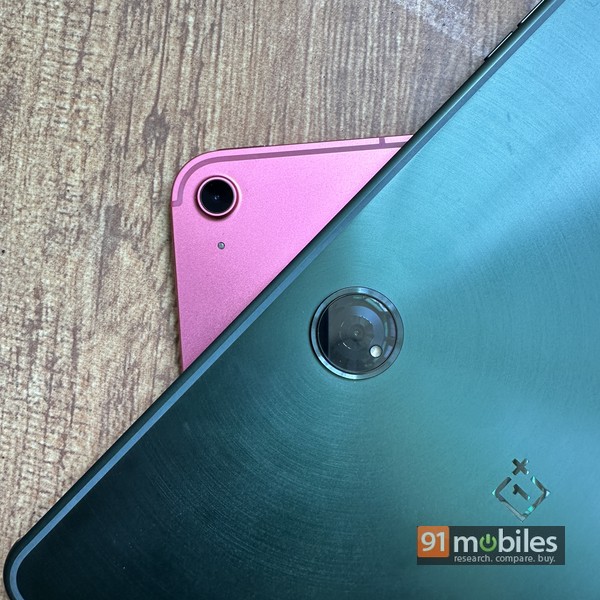
Both tablets have highlighted their front-facing cameras, especially for video calls. And each tablet’s selfie snapper comes with its own version of subject tracking. Centre Stage on the iPad keeps the subject in the centre while the OnePlus Pad uses what it calls Limelight technology to do the same. The iPad, however, handles this better and also packs in a camera with a higher megapixel count – 12 megapixels as against 8 megapixels on the OnePlus Pad. We can actually think of using the iPad’s front-facing camera (and it is on the longer side for the first time on an iPad) as a content creation tool, while the OnePlus Pad is best limited to good-quality video calls. The 12-megapixel rear camera of the iPad is also a notch above in terms of colour and detail as compared to the 13-megapixel rear snapper on the OnePlus Pad, although we doubt you will be using either for serious photography or videography.
Winner: iPad
Software: iPadOS rules, as Android still tries to digest the tablet pill
This is where the iPad really scores. OnePlus has tweaked OxygenOS to be more tablet friendly, and has brought in features like floating windows and split-screen apps, but it all seems to work just way more smoothly on the iPad with iPadOS. Apple’s ecosystem also means that there are apps that are dedicated to the iPad, and do not look like stretched-out versions of phone apps. As in the case of the processor, it’s an ecosystem thing. This is one department where Android tablets need to catch up with the iPad, and while the OnePlus Pad comes with a typically clean UI with no clutter, it still has some way to go before it can match iPadOS. OnePlus will also have its work cut out matching the awesome update record of the iPad. Perhaps the most clear cut round of this battle.
Winner: iPad
Battery life and charging: SuperVOOC charging wins
This is one area where the OnePlus Pad surprised us. The iPad is legendary for its 10-11 hour battery life. Well, the OnePlus Pad not only matches and often exceeds that in spite of its larger display and higher refresh rate, but also brings fast charging to the tablet table with support for 67W charging and a 67W SuperVOOC charger in the box. That charges the OnePlus Pad in about 80 minutes, which is less than half the time it takes to charge an iPad (generally about 2.5-3 hours if you use the 20W charger that comes with it). This is a clean win for the OnePlus Pad.
Winner: OnePlus Pad.
Productivity: Enterprising stuff
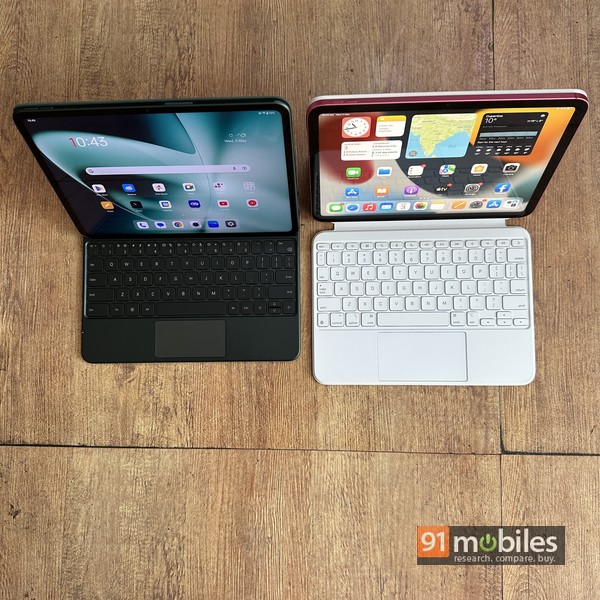
The days when a tablet was the ‘third screen” that fitted in between the smartphone and the notebook are now history. Today, tablets, and premium-priced tablets especially, are expected to step in and do the work of a notebook when the need arises. The iPad’s software edge here made a telling difference. The iPad simply works more smoothly and what’s more comes with a vastly superior array of apps pre-installed – the tablet versions of Pages, Keynote and Numbers work a whole lot better than WPS Office that the OnePlus Pad comes with. From editing images and videos to writing notes, everything seems to work more smoothly on the iPad. The OnePlus Pad does come with some integrations with OnePlus devices but these are still in their infancy. If you are looking to do high-level productivity tasks on a tablet, the iPad still is the chosen one. Even the Apple Pencil does more on the iPad than the OnePlus stylus does on the OnePlus Pad. The fact that the iPad has a fingerprint scanner and the OnePlus Pad does not is just the icing on the tablet productivity cake!
Winner: iPad
General usage: Just routine stuff
In terms of general everyday usage like web browsing, social networks, watching the odd video and handing messages, we found the iPad and the OnePlus Pad being pretty much evenly matched. The iPad’s software superiority does make a difference of course, with apps just fitting and running better on Apple’s tablet, but the OnePlus Pad is a superb device for viewing content. The OnePlus Pad’s slightly larger display gives you not only a bigger viewing area but also a slightly larger keyboard to type on, and the speakers do make a difference even for routine video calls. On the other hand, the fingerprint scanner on the iPad does give it a bit of an edge in privacy terms. The iPad also comes with a cellular option (at a much higher price, be it noted) which the OnePlus Pad lacks, although it connects very smoothly to Wi-Fi hotspots and is expected to automatically connect to OnePlus phones’ cellular networks in the coming days.
Winner: iPad
Accessories: Bring on the keyboard and stylus
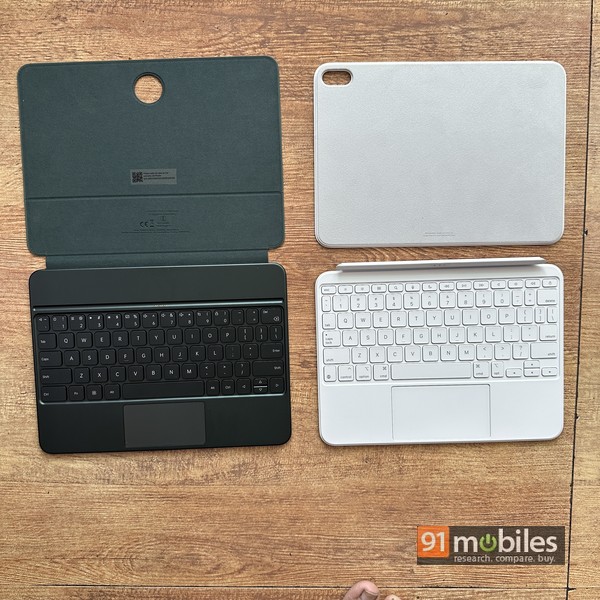
We normally do not make this category but with the iPad and the OnePlus Pad, it makes sense to factor in their accessories too. Both tablets have keyboards that can make them double up as notebooks of sorts – Apple has marketed the Magic Keyboard Folio for the iPad (10th generation) while the OnePlus Pad works with the optional OnePlus Magnetic Keyboard. Both keyboards attach to the tablets via pogo pins and both keyboards also have trackpads, but there the similarity ends. The Magic Keyboard Folio comprises two separate pieces – a back cover with a kickstand, and the keyboard itself. The OnePlus Magnetic Keyboard is a single-piece affair, very similar to Apple’s early Smart Keyboard, with the back cover and keyboard attached to each other. The OnePlus Magnetic Keyboard is a little larger, but it is the Apple keyboard which is easier to use with six rows of keys and a larger trackpad as compared to the five rows on the OnePlus keyboard. That said, the OnePlus Magnetic Keyboard’s price tag of Rs 7,999 makes it a far more viable option than the rather steep Rs 24,900 Apple asks for the Magic Keyboard Folio.
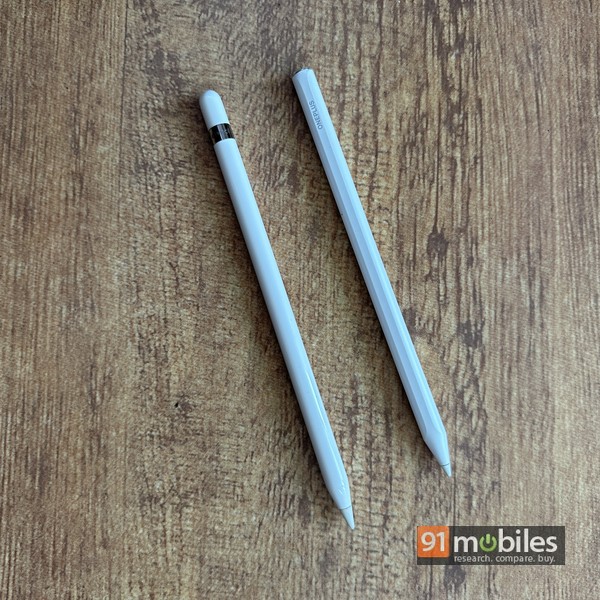
In terms of styluses, the iPad works a whole lot better with the Apple Pencil as compared to the OnePlus Pad and its stylus, the OnePlus Stylus, which is rather basic at the time of writing, and has no handwriting recognition of its own (the iPad and Apple Pencil have Scribble). That said, it is rather odd that the newest iPad actually works with the older Apple Pencil and not the Apple Pencil (2nd generation), which means you actually have to purchase a separate dongle to charge the Apple Pencil. Once again, the OnePlus Stylus comes with a much lower price tag of Rs 4,999, as compared to the Rs 9,500 of the Apple Pencil.
The iPad’s accessories, especially the stylus, work more smoothly with the tablet. Still, that price differential is massive enough for us to give this round to OnePlus – you can get the OnePlus keyboard and stylus for less than the price of a Magic Keyboard Folio alone. That said, if you are looking to do a lot of work with a stylus, the iPad and Apple Pencil combination is streets ahead!
Winner: OnePlus Pad
Price: Billing it!
The OnePlus Pad is available at Rs 37,999 for its base 8GB / 128GB and Rs 39,999 for its 12GB / 256GB variant. Both of these are below the price of the iPad (10th generation), which comes with an official price tag of Rs 44,900 for 64GB and Rs 59,900 for 256GB for its Wi-Fi only models. Add Cellular connectivity and the iPad’s price shoots up to Rs 59,900 for 64GB and Rs 74,900 for 256GB. To be fair, the iPad is often available at slightly lower prices from many retailers, but even factoring that in, there is no doubt that the OnePlus Pad wins this round very comfortably indeed. We just wish it had a 5G variant.
Winner: OnePlus Pad
Verdict: Which one to go for?
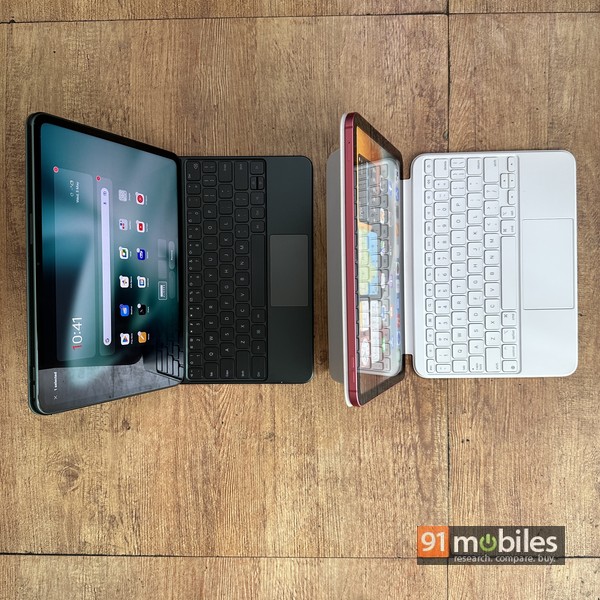
So which of the two tablets should you go for? Well, as always, it depends on what you need to do with a tablet. The iPad was launched as the third screen by Steve Jobs, but ironically, it is the OnePlus Pad that fulfills that role better at the time of writing. It is a terrific device for viewing and consuming content, with a very good display, great sound and super battery life. It is, however, when we move into the productivity zone that the iPad pulls decisively away with markedly superior software, a better app ecosystem, a great stylus, and a fingerprint scanner. There is a lot of hardware muscle on the OnePlus Pad but its software so far cannot really make the most of it, and that is a pity because it takes the edge off its very well-designed and far more affordable accessories.
If the budget is a crucial factor, it is the OnePlus Pad all the way – you can get the 12GB / 256GB variant with the keyboard and stylus for less than the price of the iPad 256GB! But what if the budget is not a problem? Go for the iPad.
We will keep this even simpler: want a tablet that can also create content and slip into notebook mode easily? Go for the iPad. Want to stay on the Android side and want a tablet with great multimedia and the option to add a tablet and stylus, which might (might!) turn out to be super in the long run? Give the OnePlus Pad a try. Think Different or Never Settle, you will end up with a good tablet on the table!






![Best affordable tablets for entertainment in India [July 2023]: Xiaomi Pad 6, OnePlus Pad, and more Thumbnail](https://www.91-cdn.com/hub/wp-content/uploads/2023/06/xiaomi-pad-6-image.jpg?tr=h-110,q-100,pr-true)





